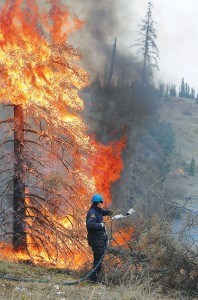
Despite a critically dry summer season, it was an uncharacteristically slow year for wildfires in Jasper National Park. The team responded to only 10 wildfires which—because they had the potential to threaten personal safety, property damage or species at risk—were kept small and quickly extinguished. Two of these wildfires (Short Creek wildfires) were located in critical caribou habitat in the northwest corner of the park.
Jasper’s Fire Management Team and Caribou Recovery Team work closely together to determine the best way to manage fire in the park to ensure caribou habitat is maintained and protected.
The fire management team was also ready to respond during times of high or extreme fire danger. For over half of the summer months, from June to August, the park was in high or extreme fire danger.
The park’s Initial Attack Crew was on high alert for 39 days during July and August. For community protection, the park issued a temporary fire ban on the Saturday Night Lake Loop during the driest period of the summer.
Winter 2014–15
Though winter has arrived, this doesn’t mean Jasper’s Fire Management Team has slowed down. Trail users may have noticed freshly cut trees and woody debris piles near the Marjorie Trail lately. This fall and early winter, Jasper National Park’s Initial Attack Crew removed vegetation in an overgrown area of the community fireguard and piled it to burn later. This helps to protect our town from approaching wildfires by strengthening the community fireguard.
As snow cover and weather safely allows this winter, the park’s Fire Management Team will also carry out prescribed burning in the Fiddle Fireguard Sub-Unit of the Fiddle Prescribed Burn Complex (a series of interconnected prescribed fire units in the east end of the park). The area to be burned is located along the east boundary of Jasper National Park, between the east park gate and the Athabasca River. Using a drip-torch (a portable fire torch), the team will burn as much of the coniferous component of this 73-hectare unit as possible, allowing for safe, easy burning of the rest of the unit in the spring or fall. When complete, this will provide a 500 metre wide downwind fireguard that will allow fire managers to safely ignite the rest of the Fiddle Complex.
Prevailing winds may push smoke to the east, making it visible near the east park gate and surrounding vicinity.
The Fiddle Prescribed Fire Complex is located in the Athabasca River Valley. The complex is approximately 300 hectares in total, and it is comprised of four subunits delineated by natural features and Highway 16.
Restoring the natural process of fire to this area will:
- Provide a fireguard across the Athabasca Valley to help stop or slow wildfire. Park efforts will compliment adjacent provincial work;
- Help stop or slow the eastward spread of Mountain Pine Beetle; and
- Restore the historical role of fire to this area (a region with a historically short fire cycle), encouraging aspen regeneration.
Parks Canada
Special to the Fitzhugh
